1997 SSANGYONG KORANDO steering
[x] Cancel search: steeringPage 1628 of 2053
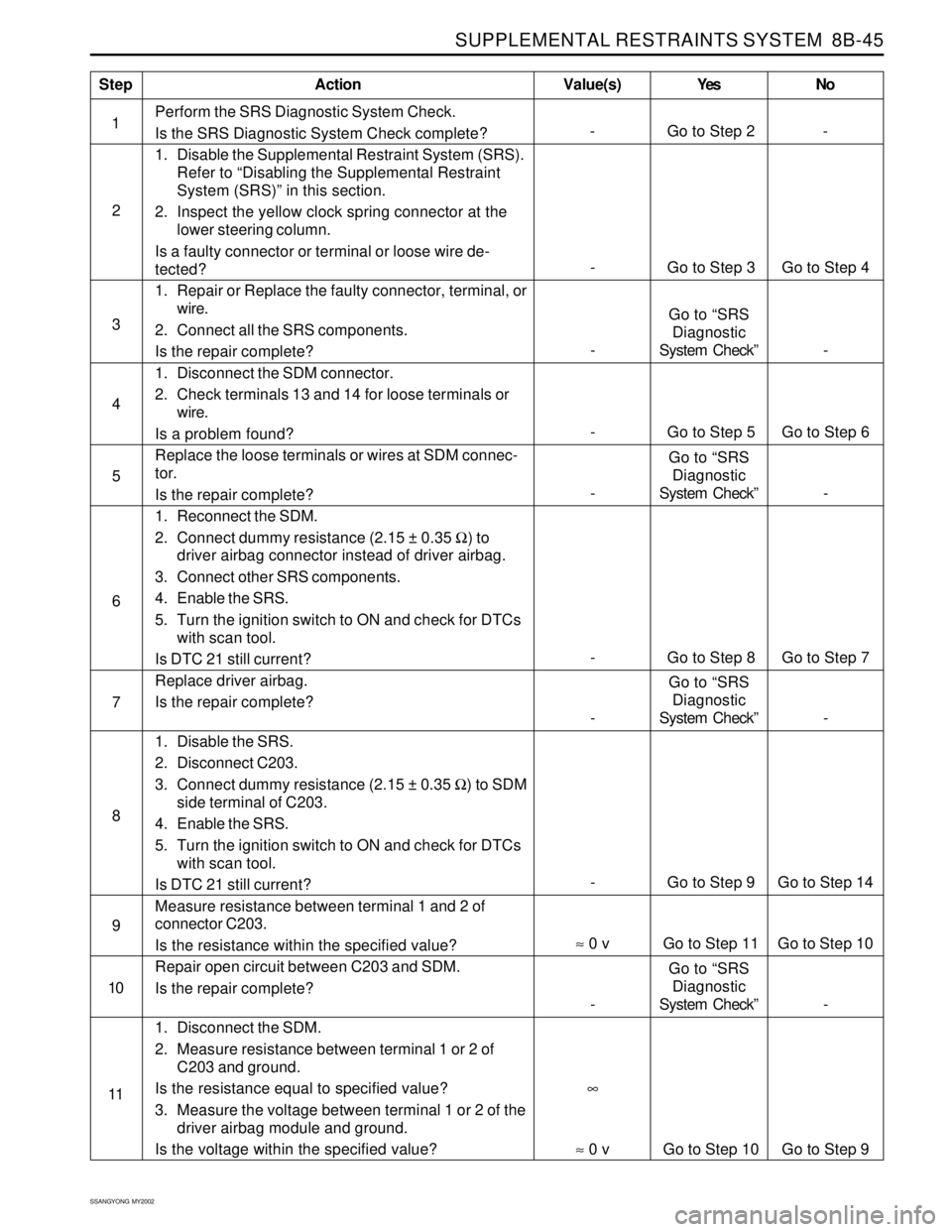
SUPPLEMENTAL RESTRAINTS SYSTEM 8B-45
SSANGYONG MY2002
Perform the SRS Diagnostic System Check.
Is the SRS Diagnostic System Check complete?
1. Disable the Supplemental Restraint System (SRS).
Refer to “Disabling the Supplemental Restraint
System (SRS)” in this section.
2. Inspect the yellow clock spring connector at the
lower steering column.
Is a faulty connector or terminal or loose wire de-
tected?
1. Repair or Replace the faulty connector, terminal, or
wire.
2. Connect all the SRS components.
Is the repair complete?
1. Disconnect the SDM connector.
2. Check terminals 13 and 14 for loose terminals or
wire.
Is a problem found?
Replace the loose terminals or wires at SDM connec-
tor.
Is the repair complete?
1. Reconnect the SDM.
2. Connect dummy resistance (2.15 ± 0.35 Ω) to
driver airbag connector instead of driver airbag.
3. Connect other SRS components.
4. Enable the SRS.
5. Turn the ignition switch to ON and check for DTCs
with scan tool.
Is DTC 21 still current?
Replace driver airbag.
Is the repair complete?
1. Disable the SRS.
2. Disconnect C203.
3. Connect dummy resistance (2.15 ± 0.35 Ω) to SDM
side terminal of C203.
4. Enable the SRS.
5. Turn the ignition switch to ON and check for DTCs
with scan tool.
Is DTC 21 still current?
Measure resistance between terminal 1 and 2 of
connector C203.
Is the resistance within the specified value?
Repair open circuit between C203 and SDM.
Is the repair complete?
1. Disconnect the SDM.
2. Measure resistance between terminal 1 or 2 of
C203 and ground.
Is the resistance equal to specified value?
3. Measure the voltage between terminal 1 or 2 of the
driver airbag module and ground.
Is the voltage within the specified value?
StepAction Value(s) Yes No
2
4
5
6
- Go to Step 3 Go to Step 4
3
-Go to “SRS
Diagnostic
System Check” -
- Go to Step 5 Go to Step 6
-Go to “SRS
Diagnostic
System Check” -
7
8
9
10
-Go to “SRS
Diagnostic
System Check” - 1
- Go to Step 2 -
∞
- Go to Step 8 Go to Step 7
-Go to “SRS
Diagnostic
System Check” -
11
- Go to Step 9 Go to Step 14
≈ 0 v Go to Step 11 Go to Step 10
≈ 0 v Go to Step 10 Go to Step 9
Page 1640 of 2053
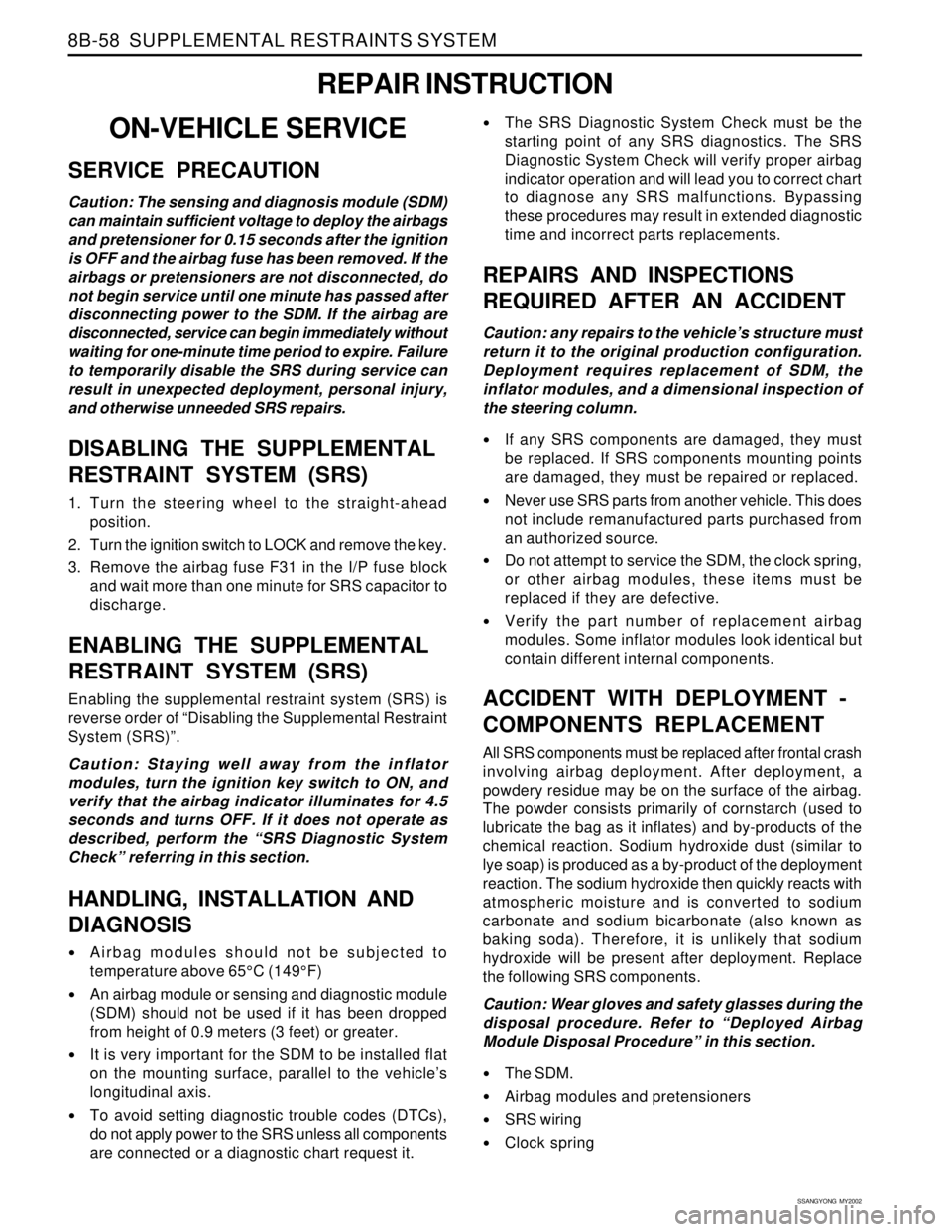
SSANGYONG MY2002
8B-58 SUPPLEMENTAL RESTRAINTS SYSTEM
REPAIR INSTRUCTION
ON-VEHICLE SERVICE
SERVICE PRECAUTION
Caution: The sensing and diagnosis module (SDM)
can maintain sufficient voltage to deploy the airbags
and pretensioner for 0.15 seconds after the ignition
is OFF and the airbag fuse has been removed. If the
airbags or pretensioners are not disconnected, do
not begin service until one minute has passed after
disconnecting power to the SDM. If the airbag are
disconnected, service can begin immediately without
waiting for one-minute time period to expire. Failure
to temporarily disable the SRS during service can
result in unexpected deployment, personal injury,
and otherwise unneeded SRS repairs.
DISABLING THE SUPPLEMENTAL
RESTRAINT SYSTEM (SRS)
1. Turn the steering wheel to the straight-ahead
position.
2. Turn the ignition switch to LOCK and remove the key.
3. Remove the airbag fuse F31 in the I/P fuse block
and wait more than one minute for SRS capacitor to
discharge.
ENABLING THE SUPPLEMENTAL
RESTRAINT SYSTEM (SRS)
Enabling the supplemental restraint system (SRS) is
reverse order of “Disabling the Supplemental Restraint
System (SRS)”.
Caution: Staying well away from the inflator
modules, turn the ignition key switch to ON, and
verify that the airbag indicator illuminates for 4.5
seconds and turns OFF. If it does not operate as
described, perform the “SRS Diagnostic System
Check” referring in this section.
HANDLING, INSTALLATION AND
DIAGNOSIS
Airbag modules should not be subjected to
temperature above 65°C (149°F)
An airbag module or sensing and diagnostic module
(SDM) should not be used if it has been dropped
from height of 0.9 meters (3 feet) or greater.
It is very important for the SDM to be installed flat
on the mounting surface, parallel to the vehicle’s
longitudinal axis.
To avoid setting diagnostic trouble codes (DTCs),
do not apply power to the SRS unless all components
are connected or a diagnostic chart request it.
The SRS Diagnostic System Check must be the
starting point of any SRS diagnostics. The SRS
Diagnostic System Check will verify proper airbag
indicator operation and will lead you to correct chart
to diagnose any SRS malfunctions. Bypassing
these procedures may result in extended diagnostic
time and incorrect parts replacements.
REPAIRS AND INSPECTIONS
REQUIRED AFTER AN ACCIDENT
Caution: any repairs to the vehicle’s structure must
return it to the original production configuration.
Deployment requires replacement of SDM, the
inflator modules, and a dimensional inspection of
the steering column.
If any SRS components are damaged, they must
be replaced. If SRS components mounting points
are damaged, they must be repaired or replaced.
Never use SRS parts from another vehicle. This does
not include remanufactured parts purchased from
an authorized source.
Do not attempt to service the SDM, the clock spring,
or other airbag modules, these items must be
replaced if they are defective.
Verify the part number of replacement airbag
modules. Some inflator modules look identical but
contain different internal components.
ACCIDENT WITH DEPLOYMENT -
COMPONENTS REPLACEMENT
All SRS components must be replaced after frontal crash
involving airbag deployment. After deployment, a
powdery residue may be on the surface of the airbag.
The powder consists primarily of cornstarch (used to
lubricate the bag as it inflates) and by-products of the
chemical reaction. Sodium hydroxide dust (similar to
lye soap) is produced as a by-product of the deployment
reaction. The sodium hydroxide then quickly reacts with
atmospheric moisture and is converted to sodium
carbonate and sodium bicarbonate (also known as
baking soda). Therefore, it is unlikely that sodium
hydroxide will be present after deployment. Replace
the following SRS components.
Caution: Wear gloves and safety glasses during the
disposal procedure. Refer to “Deployed Airbag
Module Disposal Procedure” in this section.
The SDM.
Airbag modules and pretensioners
SRS wiring
Clock spring
Page 1641 of 2053
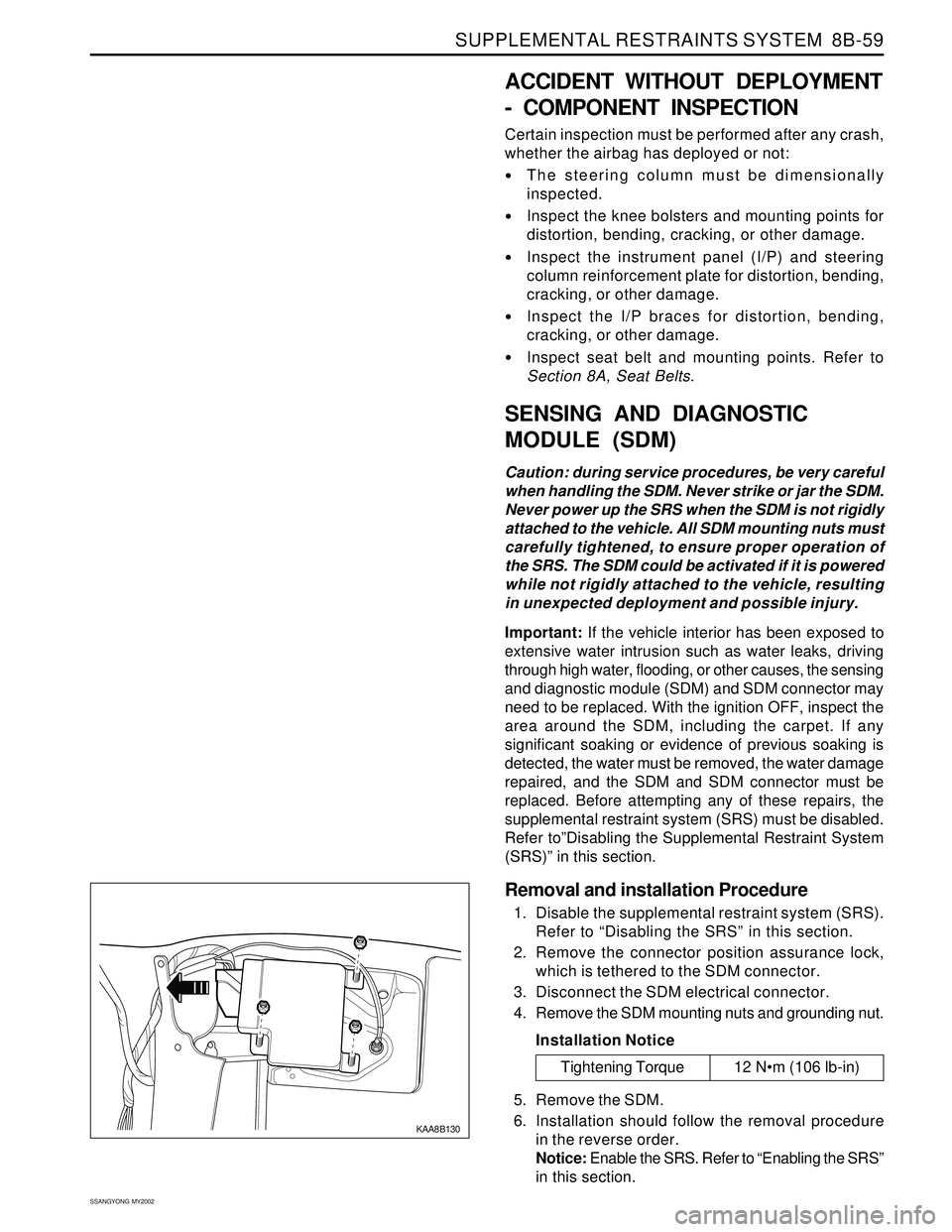
SUPPLEMENTAL RESTRAINTS SYSTEM 8B-59
SSANGYONG MY2002
KAA8B130
ACCIDENT WITHOUT DEPLOYMENT
- COMPONENT INSPECTION
Certain inspection must be performed after any crash,
whether the airbag has deployed or not:
The steering column must be dimensionally
inspected.
Inspect the knee bolsters and mounting points for
distortion, bending, cracking, or other damage.
Inspect the instrument panel (I/P) and steering
column reinforcement plate for distortion, bending,
cracking, or other damage.
Inspect the I/P braces for distortion, bending,
cracking, or other damage.
Inspect seat belt and mounting points. Refer to
Section 8A, Seat Belts.
SENSING AND DIAGNOSTIC
MODULE (SDM)
Caution: during service procedures, be very careful
when handling the SDM. Never strike or jar the SDM.
Never power up the SRS when the SDM is not rigidly
attached to the vehicle. All SDM mounting nuts must
carefully tightened, to ensure proper operation of
the SRS. The SDM could be activated if it is powered
while not rigidly attached to the vehicle, resulting
in unexpected deployment and possible injury.
Important: If the vehicle interior has been exposed to
extensive water intrusion such as water leaks, driving
through high water, flooding, or other causes, the sensing
and diagnostic module (SDM) and SDM connector may
need to be replaced. With the ignition OFF, inspect the
area around the SDM, including the carpet. If any
significant soaking or evidence of previous soaking is
detected, the water must be removed, the water damage
repaired, and the SDM and SDM connector must be
replaced. Before attempting any of these repairs, the
supplemental restraint system (SRS) must be disabled.
Refer to”Disabling the Supplemental Restraint System
(SRS)” in this section.
Removal and installation Procedure
1. Disable the supplemental restraint system (SRS).
Refer to “Disabling the SRS” in this section.
2. Remove the connector position assurance lock,
which is tethered to the SDM connector.
3. Disconnect the SDM electrical connector.
4. Remove the SDM mounting nuts and grounding nut.
Installation Notice
5. Remove the SDM.
6. Installation should follow the removal procedure
in the reverse order.
Notice: Enable the SRS. Refer to “Enabling the SRS”
in this section.
Tightening Torque 12 Nm (106 lb-in)
Page 1642 of 2053

SSANGYONG MY2002
8B-60 SUPPLEMENTAL RESTRAINTS SYSTEM
KAA8B140
DRIVER AIRBAG MODULE
Removal and installation Procedure
1. Disconnect the negative battery cable.
Caution: The SDM can maintain sufficient
voltage to deploy the airbags for 0.15 seconds
after the Ignition is OFF and the airbag fuse has
been removed. If the airbags are not
disconnected, service cannot begin until one
minute has passed after disconnecting power
to the SDM. If the airbags are disconnected,
service can begin immediately without waiting
for one-minute time period to expire. Failure to
temporarily disable the SRS during service
result in unexpected deployment, personal
injury, and otherwise unneeded SRS repair.
2. Disable the supplemental restraint system (SRS).
Refer to “Disabling the SRS” in this section.
3. Position the steering wheel straight ahead.
4. Remove the driver airbag module mounting bolts.
Installation Notice
Caution: When handling an airbag module,
always keeps the top of the unit facing upward.
This leaves room for the airbag to expand if the
module unexpectedly deploys. Without room
for expansion, a module suddenly propelled
toward a person or object can cause injury or
vehicle damage.
5. Remove the connector from the horn terminal and
the driver airbag module.
6. Remove the driver airbag module.
7. Installation should follow the removal procedure
in the reverse order.
Tightening Torque 8 Nm (71 lb-in)
Page 1643 of 2053
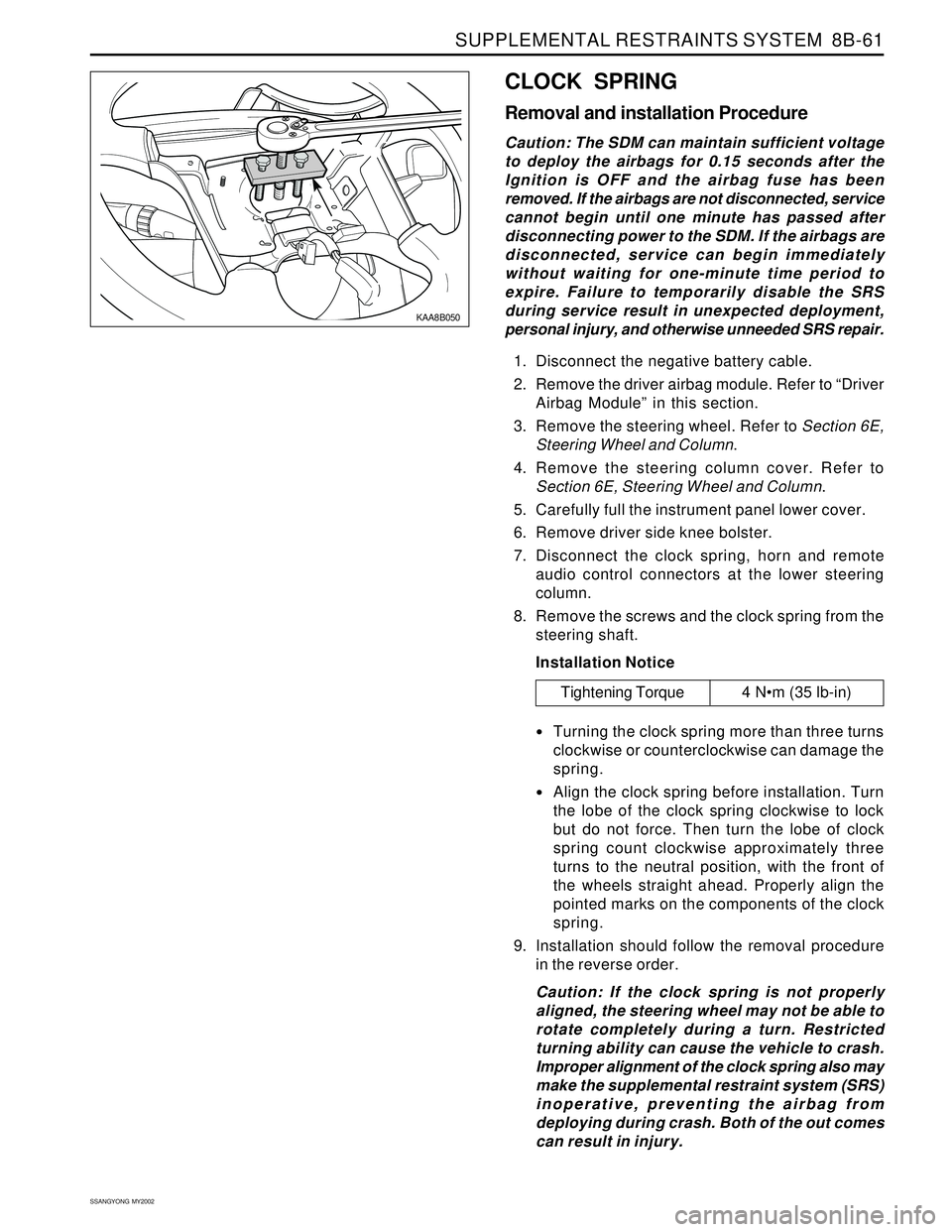
SUPPLEMENTAL RESTRAINTS SYSTEM 8B-61
SSANGYONG MY2002
KAA8B050
CLOCK SPRING
Removal and installation Procedure
Caution: The SDM can maintain sufficient voltage
to deploy the airbags for 0.15 seconds after the
Ignition is OFF and the airbag fuse has been
removed. If the airbags are not disconnected, service
cannot begin until one minute has passed after
disconnecting power to the SDM. If the airbags are
disconnected, service can begin immediately
without waiting for one-minute time period to
expire. Failure to temporarily disable the SRS
during service result in unexpected deployment,
personal injury, and otherwise unneeded SRS repair.
1. Disconnect the negative battery cable.
2. Remove the driver airbag module. Refer to “Driver
Airbag Module” in this section.
3. Remove the steering wheel. Refer to Section 6E,
Steering Wheel and Column.
4. Remove the steering column cover. Refer to
Section 6E, Steering Wheel and Column.
5. Carefully full the instrument panel lower cover.
6. Remove driver side knee bolster.
7. Disconnect the clock spring, horn and remote
audio control connectors at the lower steering
column.
8. Remove the screws and the clock spring from the
steering shaft.
Installation Notice
Turning the clock spring more than three turns
clockwise or counterclockwise can damage the
spring.
Align the clock spring before installation. Turn
the lobe of the clock spring clockwise to lock
but do not force. Then turn the lobe of clock
spring count clockwise approximately three
turns to the neutral position, with the front of
the wheels straight ahead. Properly align the
pointed marks on the components of the clock
spring.
9. Installation should follow the removal procedure
in the reverse order.
Caution: If the clock spring is not properly
aligned, the steering wheel may not be able to
rotate completely during a turn. Restricted
turning ability can cause the vehicle to crash.
Improper alignment of the clock spring also may
make the supplemental restraint system (SRS)
inoperative, preventing the airbag from
deploying during crash. Both of the out comes
can result in injury.
Tightening Torque 4 Nm (35 lb-in)
Page 1645 of 2053
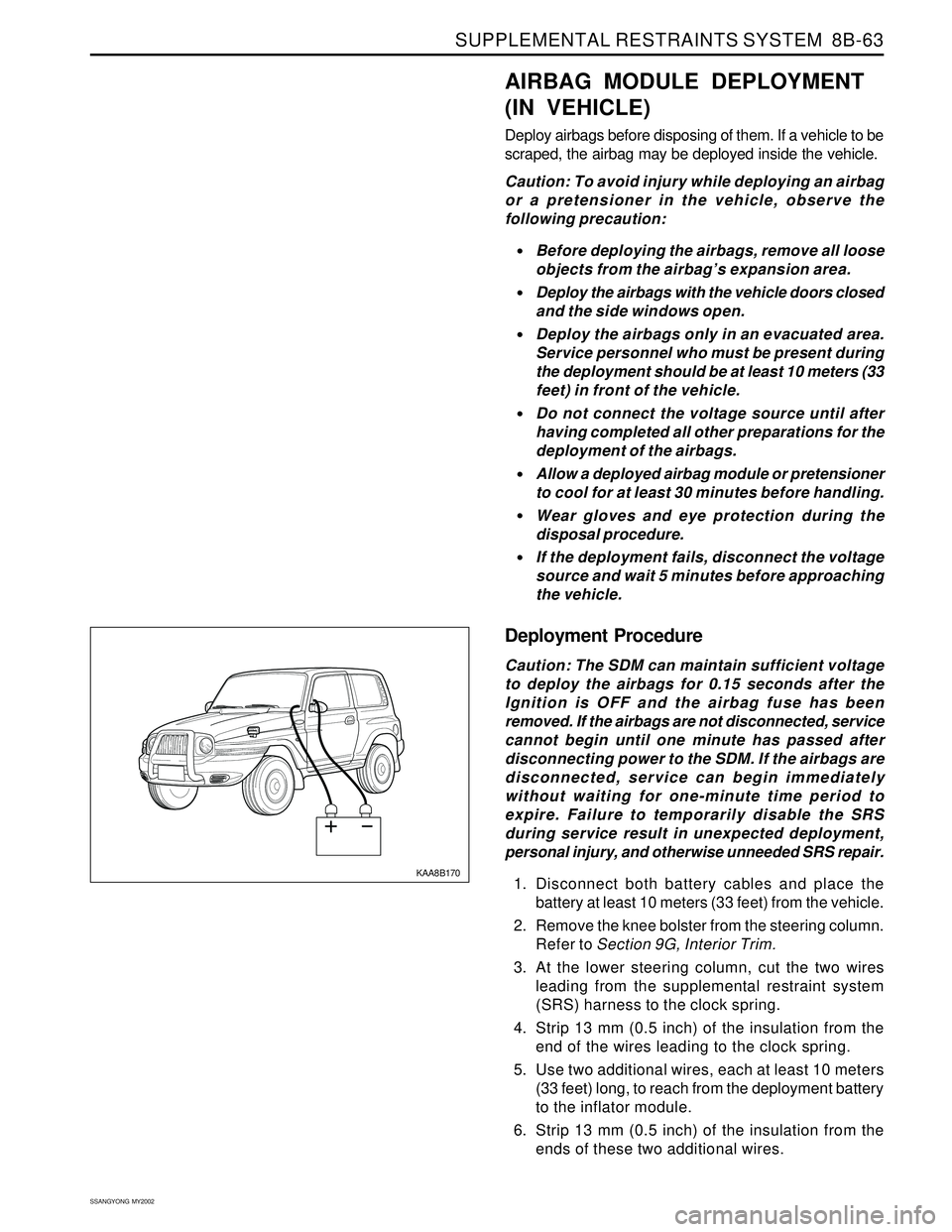
SUPPLEMENTAL RESTRAINTS SYSTEM 8B-63
SSANGYONG MY2002
KAA8B170
AIRBAG MODULE DEPLOYMENT
(IN VEHICLE)
Deploy airbags before disposing of them. If a vehicle to be
scraped, the airbag may be deployed inside the vehicle.
Caution: To avoid injury while deploying an airbag
or a pretensioner in the vehicle, observe the
following precaution:
Before deploying the airbags, remove all loose
objects from the airbag’s expansion area.
Deploy the airbags with the vehicle doors closed
and the side windows open.
Deploy the airbags only in an evacuated area.
Service personnel who must be present during
the deployment should be at least 10 meters (33
feet) in front of the vehicle.
Do not connect the voltage source until after
having completed all other preparations for the
deployment of the airbags.
Allow a deployed airbag module or pretensioner
to cool for at least 30 minutes before handling.
Wear gloves and eye protection during the
disposal procedure.
If the deployment fails, disconnect the voltage
source and wait 5 minutes before approaching
the vehicle.
Deployment Procedure
Caution: The SDM can maintain sufficient voltage
to deploy the airbags for 0.15 seconds after the
Ignition is OFF and the airbag fuse has been
removed. If the airbags are not disconnected, service
cannot begin until one minute has passed after
disconnecting power to the SDM. If the airbags are
disconnected, service can begin immediately
without waiting for one-minute time period to
expire. Failure to temporarily disable the SRS
during service result in unexpected deployment,
personal injury, and otherwise unneeded SRS repair.
1. Disconnect both battery cables and place the
battery at least 10 meters (33 feet) from the vehicle.
2. Remove the knee bolster from the steering column.
Refer to Section 9G, Interior Trim.
3. At the lower steering column, cut the two wires
leading from the supplemental restraint system
(SRS) harness to the clock spring.
4. Strip 13 mm (0.5 inch) of the insulation from the
end of the wires leading to the clock spring.
5. Use two additional wires, each at least 10 meters
(33 feet) long, to reach from the deployment battery
to the inflator module.
6. Strip 13 mm (0.5 inch) of the insulation from the
ends of these two additional wires.
Page 1676 of 2053
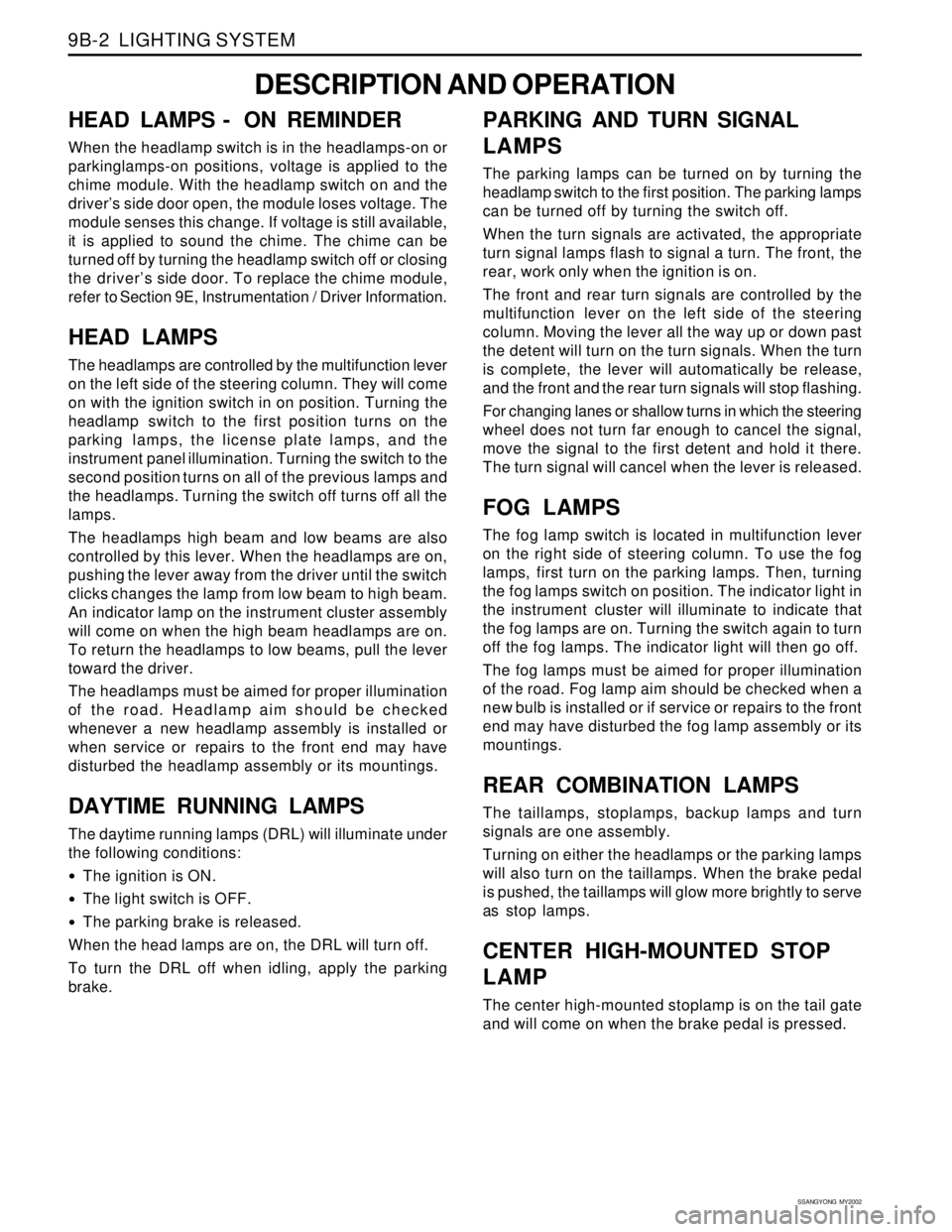
SSANGYONG MY2002
9B-2 LIGHTING SYSTEM
DESCRIPTION AND OPERATION
HEAD LAMPS - ON REMINDER
When the headlamp switch is in the headlamps-on or
parkinglamps-on positions, voltage is applied to the
chime module. With the headlamp switch on and the
driver’s side door open, the module loses voltage. The
module senses this change. If voltage is still available,
it is applied to sound the chime. The chime can be
turned off by turning the headlamp switch off or closing
the driver’s side door. To replace the chime module,
refer to Section 9E, Instrumentation / Driver Information.
HEAD LAMPS
The headlamps are controlled by the multifunction lever
on the left side of the steering column. They will come
on with the ignition switch in on position. Turning the
headlamp switch to the first position turns on the
parking lamps, the license plate lamps, and the
instrument panel illumination. Turning the switch to the
second position turns on all of the previous lamps and
the headlamps. Turning the switch off turns off all the
lamps.
The headlamps high beam and low beams are also
controlled by this lever. When the headlamps are on,
pushing the lever away from the driver until the switch
clicks changes the lamp from low beam to high beam.
An indicator lamp on the instrument cluster assembly
will come on when the high beam headlamps are on.
To return the headlamps to low beams, pull the lever
toward the driver.
The headlamps must be aimed for proper illumination
of the road. Headlamp aim should be checked
whenever a new headlamp assembly is installed or
when service or repairs to the front end may have
disturbed the headlamp assembly or its mountings.
DAYTIME RUNNING LAMPS
The daytime running lamps (DRL) will illuminate under
the following conditions:
The ignition is ON.
The light switch is OFF.
The parking brake is released.
When the head lamps are on, the DRL will turn off.
To turn the DRL off when idling, apply the parking
brake.
PARKING AND TURN SIGNAL
LAMPS
The parking lamps can be turned on by turning the
headlamp switch to the first position. The parking lamps
can be turned off by turning the switch off.
When the turn signals are activated, the appropriate
turn signal lamps flash to signal a turn. The front, the
rear, work only when the ignition is on.
The front and rear turn signals are controlled by the
multifunction lever on the left side of the steering
column. Moving the lever all the way up or down past
the detent will turn on the turn signals. When the turn
is complete, the lever will automatically be release,
and the front and the rear turn signals will stop flashing.
For changing lanes or shallow turns in which the steering
wheel does not turn far enough to cancel the signal,
move the signal to the first detent and hold it there.
The turn signal will cancel when the lever is released.
FOG LAMPS
The fog lamp switch is located in multifunction lever
on the right side of steering column. To use the fog
lamps, first turn on the parking lamps. Then, turning
the fog lamps switch on position. The indicator light in
the instrument cluster will illuminate to indicate that
the fog lamps are on. Turning the switch again to turn
off the fog lamps. The indicator light will then go off.
The fog lamps must be aimed for proper illumination
of the road. Fog lamp aim should be checked when a
new bulb is installed or if service or repairs to the front
end may have disturbed the fog lamp assembly or its
mountings.
REAR COMBINATION LAMPS
The taillamps, stoplamps, backup lamps and turn
signals are one assembly.
Turning on either the headlamps or the parking lamps
will also turn on the taillamps. When the brake pedal
is pushed, the taillamps will glow more brightly to serve
as stop lamps.
CENTER HIGH-MOUNTED STOP
LAMP
The center high-mounted stoplamp is on the tail gate
and will come on when the brake pedal is pressed.
Page 1705 of 2053

SSANGYONG MY2002
9C-2 HORNS
DESCRIPTION AND OPERATION
HORNS
The horns are located in the front bumper. They are at
tached near the radiator at the front of the vehicle. The
horns are actuated by pressing the steering wheel pad,
which grounds the horns’ electrical circuit.